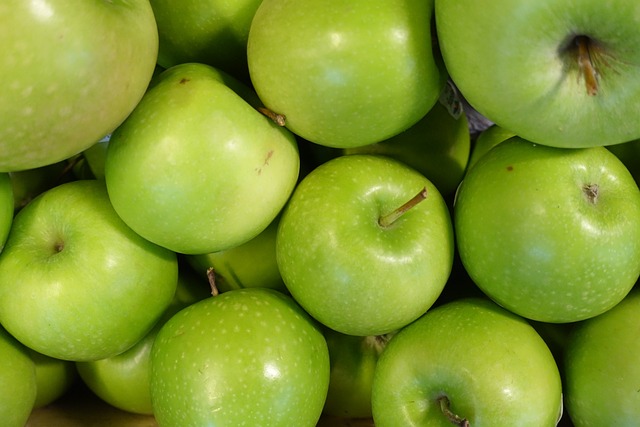
🍏Granny Smith apples are renowned for their tart flavor and striking green hue, which result from a unique combination of genetic factors and environmental conditions. These apples are a nutritious choice, high in antioxidants like flavonoids, vitamin C, fiber, and boasting a lower glycemic index than sweeter varieties. Originating from a mutated seedling in Australia, they're particularly well-suited to USDA hardiness zones 5 through 8 with fertile, slightly acidic soil and full to partial sunlight. In the kitchen, Granny Smith apples add a tangy zest that can brighten both sweet and savory dishes, from pies and salads to main courses and soups, offering a versatile culinary ingredient that can elevate any recipe with its unique flavor profile.
Granny Smith apples, renowned for their vibrant green hue and distinctive tart flavor, offer more than just a pop of color on your dinner plate. This comprehensive article delves into the multifaceted world of Granny Smith apples, exploring their scientific attributes, nutritional advantages, and the optimal conditions for their cultivation. From their journey from orchard to market to their versatile culinary applications, we uncover the myriad ways these green gems can enhance your diet and elevate your cooking experiences. Discover how Granny Smith apples compare to other varieties, the benefits of organic versus conventional farming methods, and innovative uses that go beyond traditional consumption. Join us as we peel back the layers of this versatile fruit’s impact on health, sustainability, and global cuisines.
- The Science Behind Granny Smith Apples' Green Hue
- Nutritional Benefits of Choosing Granny Smith Over Other Apple Varieties
- Cultivation and Growing Conditions for Optimal Granny Smith Apple Production
- Culinary Uses of Granny Smith Apples: From Sweet to Savory
The Science Behind Granny Smith Apples' Green Hue

Granny Smith apples are renowned for their distinctive green hue, a trait that sets them apart from other apple varieties. The green color is primarily due to the presence of chlorophyll, which is stored in the apple’s skin. Chlorophyll is the pigment found in plants that enables them to perform photosynthesis, absorbing light energy from the sun and converting it into chemical energy. In Granny Smith apples, this process continues even after harvest, preserving their vibrant green color longer than many other apple varieties. The variety was first developed in Sydney, Australia, in 1850 by Maria Ann Thompson, who is also known as Lady Elizabeth Macarthur. She cultivated a seedling from a chance mutation of a French crab apple, and this original tree became the progenitor for all Granny Smith apples grown today. The environmental conditions during the apple’s growth, such as sunlight exposure, temperature, and soil nutrients, can influence the intensity and shade of the green hue, contributing to the complex interplay between genetics and environment that determines the final color of the fruit.
Nutritional Benefits of Choosing Granny Smith Over Other Apple Varieties

Granny Smith apples, renowned for their distinctive tart flavor and vibrant green hue, offer a plethora of nutritional benefits that set them apart from other apple varieties. These apples are particularly rich in antioxidants, including flavonoids such as quercetin and epicatechin, which play a crucial role in neutralizing free radicals and supporting overall health. The high levels of vitamin C found in Granny Smith apples contribute to a healthy immune system, making them an excellent choice for maintaining resilience against common illnesses. Additionally, these apples contain higher concentrations of dietary fiber compared to other apple varieties, aiding digestion and promoting satiety, which can be beneficial for weight management and blood sugar control. The fibrous content also supports the growth of beneficial gut bacteria, further contributing to digestive health. Furthermore, Granny Smiths have a lower glycemic index than many sweet apple varieties, making them a preferred choice for individuals monitoring their blood sugar levels or managing diabetes. Incorporating Granny Smith apples into your diet not only adds a refreshing and tangy element to meals but also bolsters health with its rich nutrient profile.
Cultivation and Growing Conditions for Optimal Granny Smith Apple Production

Granny Smith apples, a cultivar of apple prized for their tart flavor and bright green skin, thrive under specific cultivation conditions. These apples originate from a chance seedling discovered in New South Wales, Australia, in 1868. To achieve optimal production of Granny Smith apples, growers must pay close attention to several key factors. The trees prefer a climate with moderate temperatures and are particularly well-suited to regions with cooler summers and mild winters. Ideally, the cultivation should occur in USDA hardiness zones 5 through 8.
The soil for Granny Smith apples should be well-drained, fertile, and slightly acidic. Adequate sunlight is crucial, with full to partial sun exposure being optimal for fruit development. Water management is also vital; consistent moisture without excessive rain or irrigation is necessary to prevent root rot while ensuring the trees remain hydrated. Proper pruning, thinning of fruits to allow for larger and better-flavored apples, and careful pest and disease management are all practices that contribute to successful Granny Smith apple production. Additionally, timing harvest just as the apples begin to change from green to yellow ensures they will have the perfect balance of tartness and sweetness. With careful attention to these environmental factors and cultivation techniques, growers can yield high-quality Granny Smith apples with a superior flavor profile that is in demand by consumers worldwide.
Culinary Uses of Granny Smith Apples: From Sweet to Savory

Granny Smith apples, a variety renowned for their tartness and vibrant green hue, are incredibly versatile in culinary applications. Their unique flavor profile, which is both zesty and slightly sweet, allows them to stand out in a wide array of dishes. In the realm of sweet preparations, Granny Smith apples shine when used in desserts such as pies, tarts, and crisps. Their sharpness provides a delightful contrast to the sugary elements, enhancing the overall flavor experience. When baked or cooked, their texture softens, releasing natural pectin that thickens fillings and sauces. This makes them ideal for pairing with caramel, chocolate, and vanilla, creating rich, complex flavors.
On the savory side, Granny Smith apples complement a myriad of dishes beyond the sweet domain. They are often sliced thin and added to salads for a tangy bite that balances heartier ingredients like roasted meats, cheese, and nuts. Their acidity can also brighten up vinaigrettes and dressings, adding a fresh zing to any salad. In addition to their traditional uses, Granny Smith apples can be incorporated into main dishes as well, such as stuffing or stews, where they contribute a subtle apple flavor without overpowering the other components. Their ability to maintain a firm texture when cooked makes them suitable for blending into soups, particularly those featuring root vegetables and cream, elevating the dish with an undeniable apple essence.
In conclusion, Granny Smith apples stand out as a versatile and nutritious fruit, offering a unique green hue that is deeply rooted in their genetic makeup, tailored by specific growing conditions. Their distinct flavor profile, which ranges from tart to tangy, makes them a coveted ingredient across various culinary applications, enhancing both sweet and savory dishes. The science behind their green hue not only fascinates but also underscores the natural beauty and healthful properties these apples possess. Nutritionally, Granny Smith apples offer a variety of benefits, including rich fiber content and high levels of vitamin C, which contribute to overall well-being. Whether you’re savoring them fresh or incorporating them into recipes, these apples are undeniably a fruitful addition to any diet. Farmers and aficionados alike recognize the importance of optimal cultivation practices to bring these green gems from orchard to table, ensuring their quality and availability year-round.






